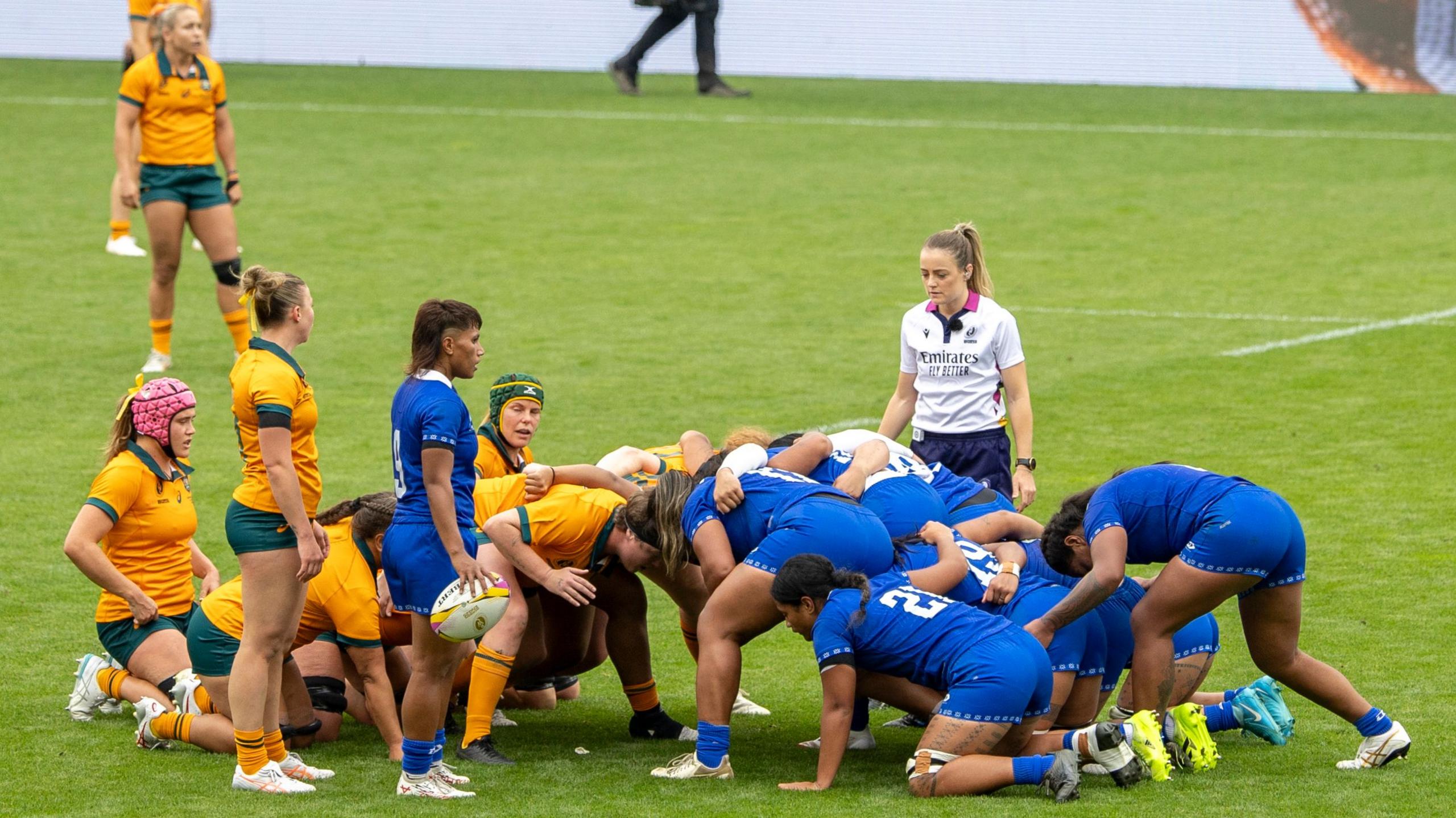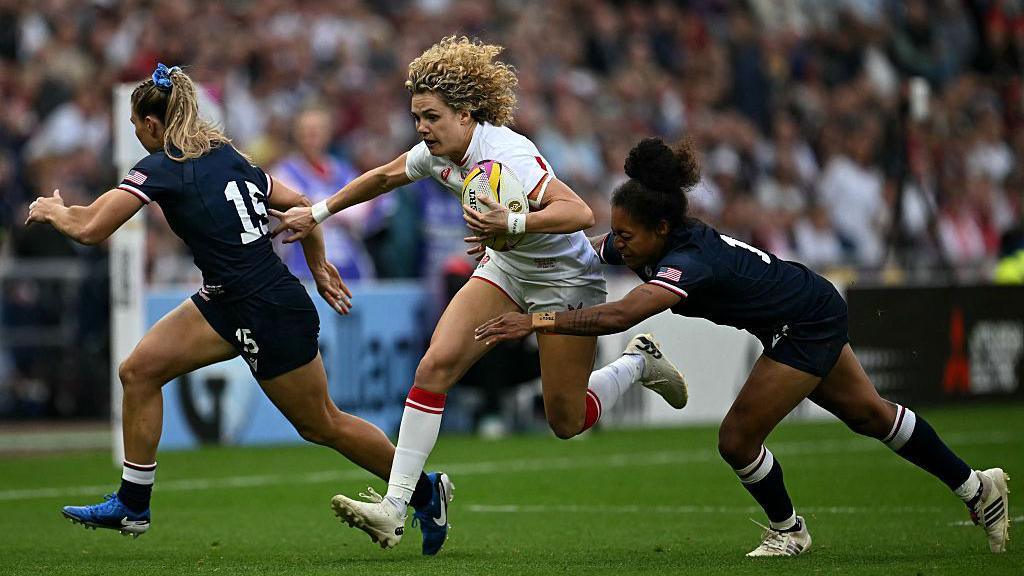What are the positions in rugby union?
- Published
The Women's Rugby World Cup is under way and you can watch every match live on the BBC.
But if you're new to the game, it may be rather confusing to follow all the terminology - particularly when it comes to the names of the players' positions.
If you don't know your prop from your wing, never fear - we're not just talking aviation here.
Here's your one-stop guide to every rugby union position...
Get in touch
Send us your questions
Forwards
Hooker
The hooker is at the centre of the scrum's front row and is the one who tries to kick the ball back to their side - or hook it, hence the name.
In the starting XV, the hooker wears number two.
The hooker is also responsible for throw-ins, known in rugby as line-outs.
Prop
There are two props in the scrum, who support the hooker. There is the loose-head, who stands to the hooker's left, and the tight-head on the right.
In the starting XV, the loose-head prop will wear number one and the tight-head wears three.
They provide power in rucks and mauls, play a support role in line-outs and are often used as battering rams when carrying the ball.
Second row
These are among the tallest and strongest players on the field and key in providing power to the forwards in scrums and mauls.
There are two second rows and they wear four and five in the starting XV.
They are responsible in line-outs for jumping, with support from the props, to catch the ball.
They are also known as locks.
Flanker
There are two flankers in a rugby union team. The blind-side flanker supports the side of the scrum closest to a touchline, with the open-side flanker supporting the side with most space.
The flankers wear numbers six and seven in the starting team.
They provide additional force in the scrum and if the ball is turned over to the opposition, they will often be the ones to have to start the new attack.
Number eight
No prizes for guessing what number this player wears!
The number eight is the player at the back of the scrum and is the link between the forwards and backs.
As well as having the physical presence of a forward, they must also be quick on their feet and skilful with their hands as they will often be tasked with picking up and running with the ball after a scrum.

There are 15 players in a rugby union team - eight forwards and seven backs
Women's Rugby World Cup - all you need to know
- Published28 August
World Cup standings, results, fixtures & BBC coverage
- Published14 September
Backs
Scrum-half
The scrum-half feeds the ball into the scrum and, all going well, will collect it when it comes out and start the attacking phase of play.
They wear the number nine in the starting XV.
Scrum-halves are often the smallest players on the field and must be agile both physically and mentally to make quick decisions and set up attacks.
Fly-half
Often the glamour player, the fly-half is central to a team's attack and will usually direct play and issue tactical instructions.
They are also usually the team's goal kicker - when the ball comes out of the scrum it will often be passed to them to kick, either for goal or to set up an attack.
In the starting XV, they wear number 10.
Centre
Each team has two centres in their starting XV - the inside centre, nearest the scrum, and the outside centre.
These players wear numbers 12 and 13.
As the name suggests, centres play in the middle of the pitch and must be good at running in attack as well as strong in the tackle against opposition backs.
Wing
There are two wings in a rugby team who in the starting XV wear numbers 11 and 14.
The left wing and right wing, as the names suggest, line up on the far sides of the pitch to provide speed and width to their team's attack.
They are usually the quickest players and should provide the main source of tries.
Full-back
A full-back wears number 15 and is often positioned well behind their team-mates when lining up on the field.
They do this to catch high balls kicked by the opposition team and to provide a last line of defence should the opponent break through the main defensive line.
The full-back is also expected to support in attacks and start moves too, so must be exceptionally quick and physically fit.
Ellie Kildunne, England's world player of the year, plays in the position for the tournament hosts.

Unlike in some games such as football, every position in rugby union is set and does not change
Replacements
Teams are allowed eight substitutes wearing shirt numbers 16-23.
There are two types of substitutes - temporary and permanent.
Temporary substitutes come on for any player who needs to go off the pitch for a head injury assessment (HIA).
They must return to the bench if the injured player is cleared to continue playing.
But if the injured player is not able to return, they become permanent.
Players can also be replaced temporarily for a blood injury, for up to 15 minutes, or if they have been injured as a result of foul play.
Permanent replacements are substitutes who come on as a direct replacement for a player on the pitch. The substituted player is not allowed to return to the pitch.
International teams must pick three specialist front row players to ensure scrums can continue safely in the event of any injury.
Scrums will become uncontested if either team cannot field a suitably trained front row.
Thank you to Danielle Ottey and Linda Johnson in Harrogate for the question.
This article is the latest from BBC Sport's Ask Me Anything team.
What is Ask Me Anything?
Ask Me Anything is a service dedicated to answering your questions.
We want to reward your time by telling you things you do not know and reminding you of things you do.
The team will find out everything you need to know and be able to call upon a network of contacts including our experts and pundits.
We will be answering your questions from the heart of the BBC Sport newsroom, and going behind the scenes at some of the world's biggest sporting events.
Our coverage will span the BBC Sport website, app, social media and YouTube accounts, plus BBC TV and radio.